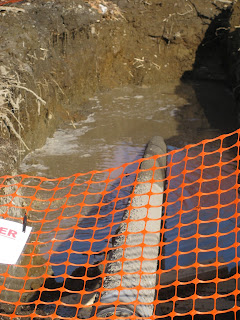Most of these were taken on Easter Sunday. No one was working, so I was able to go places I'd not been before. I am also adding most of an email from my Uncle Randy. He shared some incredibly insightful things and when you know not much at all, every speck in information is shared! So, I did!
Excerpt from Email:
The pipeline pictures
were fun for me since Stack Bros where I worked for 16 years also did pipeline
work. The equipment you see down in the ditch is a excavator (large back
hoe), a directional boring machine (middle of equipment), vac truck and supporting
parts and pieces.
The excavator is used
for digging open trenching for the pipe. The directional Boeing equipment
is used to drill a hole for running the pipe under roads, creeks or
rivers. It drills from the equipment end and when the drill end reaches
the end of the distance they want to drill under the same drill length length
is used to pull a longer length of pipe back to where it began the
drilling. It eliminates the need to dig a long wide trench and disrupt
traffic or disturb water ways. If you get a chance to watch them pull a
length of pipe back through the drill hole it is interesting to
see.
The pipe is joined
together by welding. Multiple ‘passes’ of welding are done on each joint
and when they are completed each joint is X-rayed to check for imperfections in
the weld. If any are found the defect is ground out and a repair weld
made on the area. The pipe is stronger at a weld than it is in any other
part of the length of pipe.
The welded area is
coated with special pipe coating material (plastics) to make sure the
pipe metal does not contact the ground at any point where it is buried in
the ground. If there is even a pin hole in the coating where the metal of
the pipe contacts the ground the result is an electrical short between the
ground and pipe. Damage to the pipe which can become a leak or failure in
the pipe. This is caused when the product being pumped through the pipe
creates static electricity that will go to ground which degrades the
metal. The coating of the pipe is an important part of pipeline safety.
The 20’ lengths of
pipe are welded end to end along the road and then placed in the open ditch or
a shorter length is ‘pulled’ back through a directional bore hole. When
the pipe is welded together the short ridged (20’) lengths become more like
spaghetti than ridged pipe. The long lengths can be lifted and set down
into the the trench without damage to them. (R. Virta)
Unfortunately, YOU can't hear Uncle Randy's voice (which is very cool) as you read this. You'll have to imagine!
The photos below are 'across' Lamplight on the other side of the Pipeline.
THEN, we got snow!!! April 4th was terrible and it snowed all night. I took these on April 5th. When I went out to get mom's paper. (it was tossed into the fresh snow and came to rest gently enfolded by white)
I went out again the next Sunday. I was surprised to see an end cap on the ground. I hope no one moves into that long straw of a pipe! I was also surprised there was an unwelded section in front of mom's drive. There really is a driveway behind that giant pile of snow and debris.
So, education and photos! I hope you enjoyed them. The work is being done elsewhere, so not much has changed this week. When things start happening in our sector again, I'll update once more!














No comments:
Post a Comment